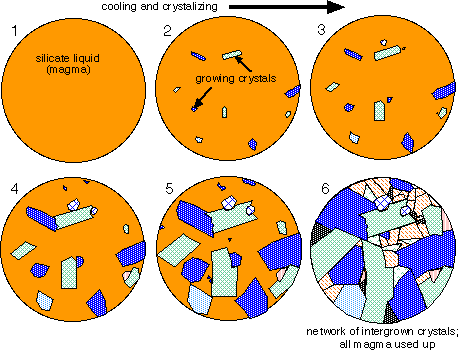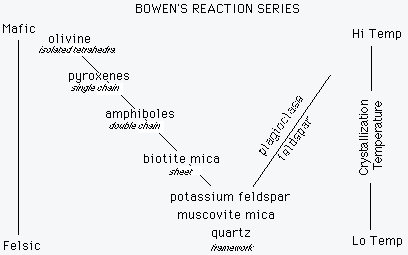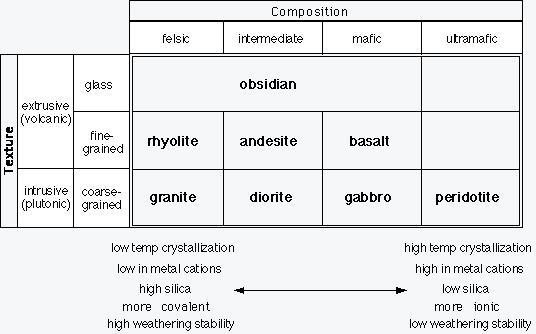(5x magnified view)

Igneous Rocks
Of the three principal rock types (igneous, sedimentary, and metamorphic), igneous rocks can be thought of as "primary" rocks because they crystallize from a liquid. Sedimentary and metamorphic rocks, which we will study later, may be thought of as derivative rocks.
Igneous rocks are rocks formed from the crystallization of a liquid (molten rock). Igneous rocks may be divided into two categories. Intrusive or plutonic rocks crystallize from magma beneath the earth's surface. Extrusive or volcanic rocks crystallize from lava at the earth's surface.
The texture of an igneous rock (fine-grained vs coarse-grained) is dependent on the rate of cooling of the melt: slow cooling allows large crystals to form, fast cooling yields small crystals. Magmas and their resultant plutonic rock bodies cool and crystallize slowly and are characterized by coarse-grained texture, in which the mineral crystals are visible to the unaided eye. On the other hand, lavas cool quickly at the earth's surface and are characterized by fine-grained texture, in which the crystals are too small to be seen by the unaided eye.
Very quickly cooled lavas, typically those quenched in water, will have a glassy texture. They cool too quickly to form crystals. Glasses do not have an orderly arrangement of atoms and there are therefore no minerals, in the strict sense, in them. Volcanic glass is called obsidian.
In addition to texture, igneous rocks may are classified according to their chemical composition. The most general classification is based on the relative abundance in a rock of felsic (feldspar and silica-quartz) minerals vs mafic (magnesium and ferrum or iron) minerals. Felsic minerals (quartz, K feldspar, etc) are light colored while mafic minerals (hornblende, pyroxenes) are normally dark colored. Felsic minerals have the lowest melting points (600 to 750 °C) and mafic minerals have higher melting points (1000 to 1200 °C).

Bowen's Reaction Series can be thought of as an idealized order of crystallization of a cooling magma. However, not all of these minerals will be crystallized together in the same rock. A mafic magma will begin crystallizing olivine and continue with pyroxenes and calcium rich plagioclase feldspar. Some amphiboles may also crystallize before the melt is used up. Mafic melts don’t have enough silica to crystallize potassium feldspar, quartz, etc. Felsic melts don't have enough iron, magnesium, and calcium to form olivine, pyroxene, or calcium plagioclase. The first-formed minerals in a felsic melt are amphiboles (hornblende) or biotite mica, along with some intermediate or sodium plagioclase. Eventually, as the melt continues to cool and becomes richer in silica (as the metal cations are used up preferentially in the double chain and sheet silicates) potassium feldspar and quartz crystallize.

Igneous rocks may be simply classified according to their chemical/mineral composition as felsic, intermediate, mafic, and ultramafic, and by texture or grain size: intrusive rocks are course grained (all crystals are visible to the naked eye) while extrusive rocks may be fine-grained (microscopic crystals) or glass (no crystalline structure; i.e., no minerals). Volcanic rocks, especially felsic and intermediate, often have a porphyritic texture characterized by visible crystals floating in a fine-grained groundmass.
Shown below is a simple classification scheme. Alternative, complex classification schemes take into account finer gradations in composition and especially the varying amounts of the elements potassium, aluminum, sodium, and calcium.
Note that felsic rocks are light in color; intermediate rocks range through grays, and mafic rocks are black in color. Ultramafic rocks (peridotite) may range black to olive green (dunite) from the mineral olivine.
